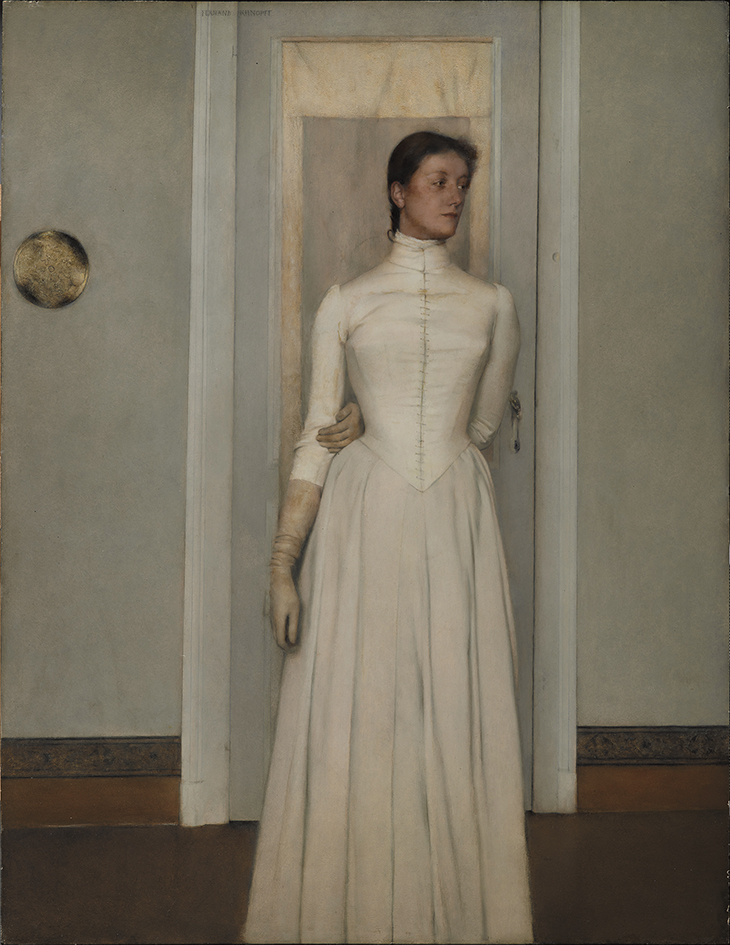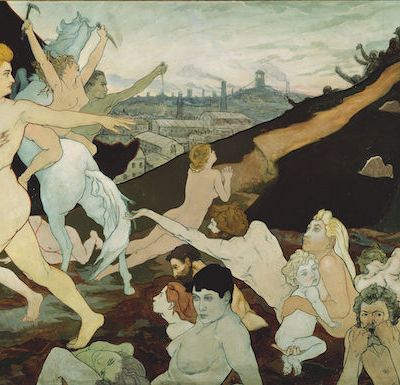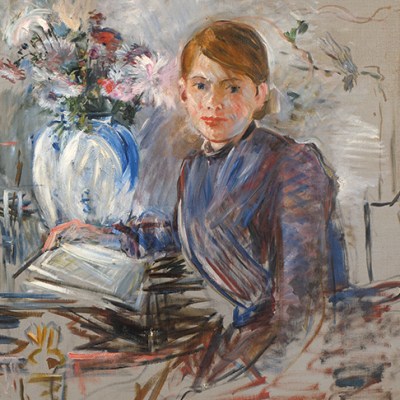Fernand Khnopff (1858–1921) was a powerfully original fin-de-siècle artist, at once a portraitist to European high society and conjuror of hermetic dream worlds that continue to enchant. His painting was rarely less than refined and pristine, sealing his human subjects behind a smooth, impervious finish. The poet and critic Émile Verhaeren compared the effect to peering through ‘disconcerting veils’. Khnopff was not just a painter but a sculptor, poster artist, illustrator and a costume and interior designer. The many facets of his artistry will be on show in Paris at an exhibition at the Petit Palais opening this month (11 December–17 March 2019). It is a fitting tribute to a painter who in his lifetime commanded a pan-European reputation. At the 1878 Universal Exhibition in Paris, Khnopff had found inspiration in the bejewelled mythologies of Gustave Moreau and the otherworldly melancholy of Edward Burne-Jones (who would become a close friend). Fusing these elements with his own elegant, oblique style, Khnopff became a sensation in the 1880s and ’90s. A whole issue of the Austrian arts journal Ver Sacrum was dedicated to him, consolidating his influence over experimental Viennese artists such as Carl Moll and Gustave Klimt.
Symbolism in literature and in painting was a defiantly cosmopolitan movement, its motifs and obsessions forming a language common to avant-garde artists everywhere. Khnopff exhibited in four of the six exhibitions of the Salon de la Rose + Croix in Paris, devised by the mystic Joséphin Péladan. The latter’s esoteric philosophy, predicated on the antagonism between the Ideal and the Real, is essential to interpreting works as perverse as Caresses (1896). Khnopff’s androgynous figures, hybrid beasts and voluptuous sphinxes dissolve the boundaries between male and female, flesh and spirit, the human and savage nature. Yet alongside his embrace of Parisian occultism, he was also a staunch Anglophile who created ornate works inspired by the poetry of Christina Rossetti. Whistler had a passionate following in Belgium, and his example inspired the austere palette and emotional opacity that defined Khnopff’s portraits, especially those of his beloved sister and muse Marguerite. So entrenched was Khnopff in English art circles that he served as correspondent for the magazine The Studio until the First World War.
Portrait of Marguerite Khnopff (1887), Fernand Khnopff. Royal Museums of Fine Arts of Belgium, Brussels. Photo: F. Maes

When disentangling his foreign influences, it is easy to overlook the importance of the Belgian context. Khnopff’s openness to foreign trends mirrored the curiosity of his small and fragile nation, eager to establish its place in Europe. Khnopff was among the most successful exports of the avant-garde society known as ‘Les XX’, founded in Brussels in 1883, and whose first logo he designed. This was a cultural insurgency led by ambitious sons of the bourgeois against the old guard or vieilles perruques whose conservative tastes seemed to clog up the artistic establishment. In a letter to his cousin Eugène Boch in November 1883, its co-founder Octave Maus complained: ‘Everything that is beautiful, free, and sincere, is stifled by a coterie of octopuses who suck up all the money, esteem, and reputation for themselves.’ He had in his sights the triennial Salon, the Academy and the jury system, which he blamed for stifling artistic creativity. Initially boasting only 15 signatories, Les XX dispensed with a president and quickly attracted artists through its flexible organisation and egalitarian principles. It went further in promoting the cause of artistic independence, which had previously been championed by groups like the Société libre des beaux-arts, founded in 1868, and its successor, La Chrysalide, whose exhibition invitations, designed by Félicien Rops in 1875, heralded the butterfly-like emergence of new talents.
Les XX had no single aesthetic programme, which makes it hard to define exactly what they stood for. The organisation was inclusive of all progressive trends in modern art, mixing Neo-Impressionism, Naturalism and Symbolism. Its moving spirits and impresarios were lawyers and collectors – Maus, Edmond Picard and Victor Arnould – who had collaborated on the journal L’Art moderne, founded in 1881, and who were politically oriented to left-wing causes. They championed artistic experiment as inherently democratic, the corollary to the campaigns for universal suffrage that rocked the political establishment. The heyday of Les XX coincided with an era of political crisis, as the country was gripped by recession, socialist agitation and in 1886 a massive general strike. In the salons of Les XX, visitors came face to face with a new iconography of proletarian heroism and defiance in the paintings and sculptures of Constantin Meunier, drawing on his observations among the mining communities of the Borinage, down near the French border. This democratic impulse was reflected in the growing presence of the decorative arts at Les XX exhibitions after 1890, breaking down the barriers between the painter and the craftsman. Khnopff too was swept up in this reformist agenda, participating in 1891 in the workers’ education programme offered at the Section d’art of the Maison du Peuple. The new premises of the Maison du Peuple, designed by Victor Horta and opened in 1891, exemplified the collectivist, modern ethos of Belgian socialism, as well as its sense of quasi-religious mission towards the masses.
Jeanne Kéfer (1885), Fernand Khnopff. J. Paul Getty Museum, Los Angeles

Les XX fostered interaction across artistic genres and media. Literary figures had a crucial role in nurturing modern art, including the novelist Camille Lemonnier and the poets Verhaeren and Maurice Maeterlinck. But music was also a fixture of Les XX exhibitions and soirées: not just the self-consciously revolutionary music of Wagner, beloved of Picard, but also intimate chamber pieces by the Belgian composer César Franck, as well as Fauré, Vincent d’Indy and eventually Debussy. It is telling that Khnopff first attracted critical attention in 1886 through a moody genre scene evoking the experience of listening to Schumann, and some of his most beguiling portraits were inspired by musicians and their families, such as Jeanne Kéfer (daughter of Gustave Kéfer, composer and performer at Les XX gatherings) and the violinist Achille Lerminiaux.
Beyond the goal of artistic freedom, Les XX was committed to national self-realisation. ‘Finally, we propose to topple everything,’ Maus ended his letter to Boch, ‘and put our poor bourgeois country back on the map’. Fifty years after comparable movements in France and Germany, the Romantic dream of forging La Jeune Belgique galvanised a generation. By the 1880s and ’90s there were around 25 different periodicals in French and Flemish championing the idea of a Belgian ‘Renaissance’. The emphasis on national rebirth put pressure on the avowed internationalism of Les XX. Although they offered a platform for exhibiting foreign artists – including Seurat, Toulouse-Lautrec, Gaugin, Rodin, Signac and Van Gogh – the society was initially wary of electing foreigners to its ranks (James Ensor dismissed the candidacy of Whistler in 1886 because his painting ‘already smells mouldy and musty’). The awkward balance between cosmopolitanism and nationalism was exacerbated by regionalist frictions, and several prominent Flemish members of Les XX, such as Piet Verhaert and Théodore Verstraete, were driven to resign or deliberately purged in the early years for their perceived conservative or regressive tendencies.
Caresses (1896), Fernand Khnopff. Royal Museums of Fine Arts of Belgium, Brussels. Photo: J. Geleyns Art Photography

The stridency of Les XX had darker political implications, as Debora Silverman has brilliantly explored. In its version of ‘juridical modernism’, the Belgian avant-garde was profoundly shaped by a milieu of ambitious lawyers, who fostered experiment within the circle known as Le jeune barreau (‘The young bar’ – Khnopff, incidentally, came from a long line of magistrates, and had been destined for a legal career). Proud of its status as a constitutional monarchy, the Belgian kingdom accorded enormous symbolic power to the law, and by extension, to its functionaries. Their supreme monument was the Palais de Justice in Brussels, a gargantuan structure planned by Joseph Poelaert to exceed the surface area of St Peter’s Basilica in Rome, and which counted at the time of its opening in 1883 as the largest building in Europe.
Silverman observes that the artistic rebellion initiated by Les XX was almost entirely devoid of bohemianism, in sharp contrast to sister movements in France. This was an avant-garde driven by one section of the bourgeois elite and which was peculiarly well-integrated into the existing social fabric. Rather than explode hierarchies, the radicals at Les XX often seemed more determined to infiltrate the state and direct it to their purposes. A compiler of the country’s law codes, and a socialist deputy in parliament, Picard was also a ferocious anti-Semite, who wanted to preserve the unique blend of Latin and Germanic elements within the ‘Belgian soul’ from corrupt and polluting influences. This vulgar racialism also explains the complicity of the Belgian bourgeoisie with the colonial ambitions of King Leopold II and his acquisition of the Congo as his personal fief in 1885. Many artists and designers happily celebrated this imperial windfall through the inclusion of exotic materials (tribal masks, sinuous vines, polished hardwoods, elephantine ivories). Traces of this murderous colonial context can still be discerned in the stylistic grammar of Belgian art nouveau.
I Lock My Door Upon Myself (1891), Fernand Khnopff. Neue Pinakothek, Munich. Photo: Photo: BPK, Berlin/Dist. RMN-Grand Palais images BStGS

Les XX was a fractious cultural movement, whose eclecticism and contradictions fostered deep rivalries. Parnassian proponents of art for art’s sake clashed violently with those who viewed art as a weapon in the fight for social justice. By 1893 Les XX had been phased out and replaced by La Libre Esthétique, less iconoclastic in spirit and more securely under Maus’s control. Amid this ferment of ideas and personalities, the quality and originality of the art produced by Belgian painters of the 1880s and 1890s was remarkable. The stylistic language of foreign exhibitors was rapidly digested, assimilated and transformed; for instance, Théo van Rysselberghe’s luminous neo-Impressionist portraits can proudly stand alongside Seurat’s example. Léon Frédéric endowed the stoicism and toil of labourers in the village of Nafraiture in Namur with the grace of Botticelli and Ghirlandaio, creating vibrant, extravagant allegories about the redemption of the working man. Meanwhile, James Ensor, a resident of Ostend, emerged as one of the most uncompromising artists of the 19th century, whose surreal and ferocious vision anticipated Symbolism and Expressionism.
But how can we account for this explosion of talent? Was it simply a by-product of ideas imported from outside? According to one monograph from the 1960s, the fin-de-siècle moment was a blip, unleashing ‘a veritable renaissance in that small country where art had been almost non-existent for several centuries’. This patronising view is typical of an older tendency to view Belgian art as simply the echo-chamber of cultural trends born elsewhere, the crossroads where external movements collided and conversed. Yet by adopting a longer chronology, we can see that the native conditions within this ‘small country’ made it possible for it to become a crucible of artistic innovation. Ever since the September Revolution of 1830, critics had poured scorn on the viability and coherence of Belgian statehood. After centuries of foreign rule – Spanish, Austrians, French and Dutch – its nine distinct provinces were seen to lack any sense of cultural unity; it had considerable industrial and financial capital, but it lacked a soul. According to the French Encyclopédie nouvelle in 1836: ‘Belgium has no history. In the past it is fragmented and dependent […] Belgium has no heart, no individual nationality.’
The Man in the Chair (1875), Henri De Braekeleer. Royal Museum of Fine Arts, Antwerp. Photo: akg-images

It was precisely to rebut such slurs that the kingdom invested in a host of ‘invented traditions’, fabricating golden legends around its crusader heroes and medieval battles for civic autonomy. In a country riven by linguistic divisions, visual culture was a central means of projecting a glorious, common past (and by implication, a glorious common future). What constituted the national style remained subject to contradictory interpretations, however. For Gustave Wappers in Brussels, to paint like a patriotic Belgian meant fidelity to the colour and exuberance of Rubens. Witness his histrionic snapshot of life and death on the barricades in the Belgian revolution, Episode from the Days of September 1830 (1835). The popular painting was accorded royal permission to be exhibited at the Musée royale de Bruxelles in 1835 alongside canvases by the baroque master. In Antwerp, an alternative artistic heritage was mined as Hendrik Leys and his nephew Henri De Braekeleer took their inspiration from the 15th-century ‘Primitives’. Braekeleer excelled at creating richly ornamented historic interiors, whose isolated human occupants seem lost in sombre meditation. This was a much more troubled vein of historicism, in which the past was either stifling in its abundance, bearing down ominously upon 19th-century individuals (as in The Man in the Chair from 1875), or alluringly inaccessible, gazed upon from an open window but tantalisingly out of reach.
The restless search for a lineage of genius and a truly national idiom had lost none of its urgency at the fin de siècle. Precisely because of its fractured past and composite present, the Belgian artistic inheritance was an unsolved puzzle, open to diverse appropriations. Ensor marshalled Bosch and Bruegel for his riotous crowd scenes and sinister social commentaries, whilst maintaining a love-hate relationship with Rubens, the epitome of earthy realism and excess. In Ensor’s 1883 self-portrait he wears the famous chapeau de paille, a parodic tribute to Rubens’ image of his sister-in-law Susanna Lunden. Khnopff, by contrast, was christened by critics ‘the modern-day Memling’, as he built on the precedents laid down by Leys and Braekeleer to fuse a meticulous naturalism with a self-contained psychological depth. Like his teacher Xavier Mellery, who produced exquisite monochrome drawings of domestic interiors suffused with a mysterious latency, Khnopff aimed to pierce the everyday world of appearances and expose ‘the soul of things’.
Portrait of the Children of Monsieur Nève (1893), Fernand Khnopff

Following Mellery’s example, Khnopff returned frequently to the eerie magic of his childhood home, Bruges. Determined only to paint the bridges and steeples of the city as filtered through his memories, he once stated he could return there as an adult only if he wore a blindfold. Such preoccupations made him the perfect illustrator for Georges Rodenbach’s visionary novel Bruges-la-Morte (1892). His frontispiece and drawing fixed the Flemish city as a haunted necropolis, presenting the medieval past as consoling and illusory. If Rodenbach was the first European novelist to integrate photographs into the unfolding text, Khnopff also sought to simulate and surpass the facile realism provided by the camera lens. Rather than simply retreat from the industrial ugliness of his age, Khnopff immersed himself in photographic processes and played with exposures to infuse all his art with an uncannily modern mode of unreality.
Memory of Flanders. A Canal (1904), Fernand Khnopff

Nineteenth-century Belgium contained multitudes, a country of painful contradictions whose art confounds attempts to put movements in orderly boxes. It was uniquely receptive to external trends; as exemplified by the exhibition ‘Paris-Bruxelles/Bruxelles-Paris’ at the Musée d’Orsay in 1997, our understanding of modern art is enormously enriched by putting both capitals into conversation. But it was also a young nation in which economic and political change had an unmatched intensity, and which had a lot to prove. Belgian cultural life oscillated between brash affirmations of novelty and consuming fantasies of a lost golden age. The hunger for origin stories, myths and legends contributed to the appeal of Symbolism, which bathed the national past in a strange, transfigured light; at the same time, for many socialists the materialism of modern Belgium seemed transient and insubstantial, standing on the brink of dramatic transformation. Influenced by the teachings of William Morris, Picard described the coming utopia of labour as a ‘new Middle Ages’. But even the most arcane or abstruse Symbolism was enmeshed in debates about national characters and forecasts of social revolution. The painter and designer Henry van de Velde declared in 1895 that ‘Beauty is a weapon and […] the means is revolutionary. We have chosen Beauty for the struggle because its nature challenges society, wounds it with permanent injury.’ In this context, Khnopff’s work can seem both cosmopolitan and insular, at once drenched in nostalgia or a herald of the hidden energies waiting to be unleashed.
‘Fernand Khnopff: Master of Enigma’ is at the Petit Palais, Paris, until 17 March 2019.
From the December 2018 issue of Apollo. Preview and subscribe here.


